Abstract
If a loss of vacuum event (LOVE) occurs due to damage of the vacuum vessel of a nuclear fusion experimental reactor, some chemical reactions such as a graphic oxidation and a buoyancy-driven exchange flow take place after equalization of the gas pressure between the inside and outside of the vacuum vessel. The graphite oxidation would generate inflammable carbon monoxide and release tritium retained in the graphite. The exchange flow through the breaches may transport the carbon monoxide and tritium out of the vacuum vessel. To add confidence to the safety evaluations and analyses, it is important to grasp the basic phenomena such as the exchange flow and the graphite oxidation. Experiments of the exchange flow and the graphite oxidation were carried out to obtain the exchange flow rate and the rate constant for the carbon monoxide combustion, respectively. These experimental results were compared with existing correlations. We plan a scaled-model test and a full-scale model test for the LOVE.
Similar content being viewed by others
References
IAEA (1991). ITER Conceptual Design Report, IAEA/ITER/DS/No. 18.
S. Matsudaet al. (1990). Conceptual design study of the Fusion Experimental Reactor (FER), Proc. 13th Int. Conf. on Plasma Physics and Controlled Nuclear Fusion Research, Washington, D.C., IAEA-CN-53/G-2-2.
M. Ogawa, T. Kunugi, and the ITER/FER safety group (1992). Experiments on exchange flow through two breaches during loss of vacuum accident in nuclear fusion experimental reactor.Fusion Technol.,21, 2036.
M. Epstein (1988). Buoyancy-driven exchange flow through a small opening in horizontal partitions.ASME, J. Heat Transfer,110, 885.
H. K. Hinssenet al. (1983). Kinetik der Graphit/Sauerstoff-Reaction im Porendiffusionsbereich, Teil 1; Matrixmaterialien A3-3 und A3-27. Jül-1875 KFA report.
H. Imai, K. Fujii, and T. Kurosawa (1982), Oxidation of graphites for core support post in air at high temperatures, JAERI-M 82-067, JAERI report (in Japanese).
JSME (1980). Formation mechanisms and controls of pollutants in combustion system, JSME, 45.
M. Hishida, M. Ogawa, T. Takeda, and M. Fumizawa (1989). Studies on the primary pipe rupture accident of a high-temperature gas cooled reactor, Proc. of 4th NURETH,1, 163.
Author information
Authors and Affiliations
Rights and permissions
About this article
Cite this article
Ogawa, M., Kunugi, T. & Seki, Y. Basic experiments during loss of vacuum event (LOVE) in fusion experimental reactor. J Fusion Energ 12, 77–81 (1993). https://doi.org/10.1007/BF01059359
Issue Date:
DOI: https://doi.org/10.1007/BF01059359




